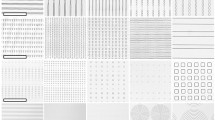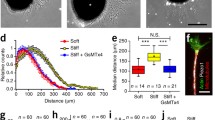Abstract
We study the effect of topographic nano-cues on neuronal growth-morphology using invertebrate neurons in culture. We use photolithography to fabricate substrates with repeatable line-pattern ridges of nano-scale heights of 10–150 nm. We plate leech neurons atop the patterned-substrates and compare their growth pattern to neurons plated atop non-patterned substrates. The model system allows us the analysis of single neurite–single ridge interactions. The use of high resolution electron microscopy reveals small filopodia processes that attach to the line-pattern ridges. These fine processes, that cannot be detected in light microscopy, add anchoring sites onto the side of the ridges, thus additional physical support. These interactions of the neuronal process dominantly affect the neuronal growth direction. We analyze the response of the entire neuronal branching tree to the patterned substrates and find significant effect on the growth patterns compared to non-patterned substrates. Moreover, interactions with the nano-cues trigger a growth strategy similarly to interactions with other neuronal cells, as reflected in their morphometric parameters. The number of branches and the number of neurites originating from the soma decrease following the interaction demonstrating a tendency to a more simplified neuronal branching tree. The effect of the nano-cues on the neuronal function deserves further investigation and will strengthen our understanding of the interplay between function and form.









Similar content being viewed by others
References
Anava S, Greenbaum A, Ben Jacob E, Hanein Y, Ayali A (2009) The regulative role of neurite mechanical tension in network development. Biophys J 96:1661–1670
Arnold M, Cavalcanti-Adam EA, Glass R, Blummel J, Eck W, Kantlehner M, Kessler H, Spatz JP (2004) Activation of integrin function by nanopatterned adhesive interfaces. Chem Phys Chem 5:383–388
Baranes K, Chejanovsky N, Alon N, Sharoni A, Shefi O (2012) Topographic cues of nano-scale height direct neuronal growth pattern. Biotechnol Bioeng. doi:10.1002/bit.24444
Britland S, Perridge C, Denyer M, Morgan H, Curtis A, Wilkinson C (1996) Morphogenetic guidance cues can interact synergistically and hierarchically in steering nerve cell growth. Exp Biol Online 1:1–11
Clark P, Connolly P, Curtis ASG, Dow JAT, Wilkinson CDW (1990) Topographical control of cell behaviour: II. Multiple grooved substrata. Development 108:635–644
Curtis A, Wilkinson C (1997) Topographical control of cells. Biomaterials 18:1573–1583
den Braber ET, de Ruijter JE, Ginsel LA, von Recum AF, Jansen JA (1998) Orientation of ECM protein deposition, fibroblast cytoskeleton, and attachment complex components on silicone microgrooved surfaces. J Biomed Mater Res 40:291–300
Dos Reis G, Fenili F, Gianfelice A, Bongiorno G, Marchesi D, Scopelliti PE, Borgonovo A, Podesta A, Indrieri M, Ranucci E, Ferruti P, Lenardi C, Milani P (2010) Direct microfabrication of topographical and chemical cues for the guided growth of neural cell networks on polyamidoamine hydrogels. Macromol Biosci 10:842–852
Fozdar DY, Lee JY, Schmidt CE, Chen S (2010) Hippocampal neurons respond uniquely to topographies of various sizes and shapes. Biofabrication 2:035005
Fricke R, Zentis PD, Rajappa LT, Hofmann B, Banzet M, Offenhausser A, Meffert SH (2011) Axon guidance of rat cortical neurons by microcontact printed gradients. Biomaterials 32:2070–2076
Hallstrom W, Martensson T, Prinz C, Gustavsson P, Montelius L, Samuelson L, Kanje M (2007) Gallium phosphide nanowires as a substrate for cultured neurons. Nano Lett 7:2960–2965
Hanson JN, Motala MJ, Heien ML, Gillette M, Sweedler J, Nuzzo RG (2009) Textural guidance cues for controlling process outgrowth of mammalian neurons. Lab Chip 9:122–131
Huber AB, Kolodkin AL, Ginty DD, Cloutier JF (2003) Signaling at the growth cone: ligand-receptor complexes and the control of axon growth and guidance. Annu Rev Neurosci 26:509–563
Hwang H, Kang G, Yeon JH, Nam Y, Park JK (2009) Direct rapid prototyping of PDMS from a photomask film for micropatterning of biomolecules and cells. Lab Chip 9:167–170
Johansson F, Carlberg P, Danielsen N, Montelius L, Kanje M (2006) Axonal outgrowth on nano-imprinted patterns. Biomaterials 27:1251–1258
Kim DH, Lipke EA, Kim P, Cheong R, Thompson S, Delannoy M, Suh KY, Tung L, Levchenko A (2010) Nanoscale cues regulate the structure and function of macroscopic cardiac tissue constructs. Proc Natl Acad Sci USA 107:565–570
Lee JW, Lee KS, Cho N, Ju BK, Lee KB, Lee SH (2007) Topographical guidance of mouse neuronal cell on SiO2 microtracks. Sens Actuators B Chem 128:252–257
Mahoney MJ, Chen RR, Tan J, Saltzman WM (2005) The influence of microchannels on neurite growth and architecture. Biomaterials 26:771–778
Meijering E, Jacob M, Sarria JC, Steiner P, Hirling H, Unser M (2004) Design and validation of a tool for neurite tracing and analysis in fluorescence microscopy images. Cytometry 58:167–176
Prinz C, Hallstrom W, Martensson T, Samuelson L, Montelius L, Kanje M (2008) Axonal guidance on patterned free-standing nanowire surfaces. Nanotechnology 19:345101-1-345101-6
Rico B, Beggs HE, Schahin-Reed D, Kimes N, Schmidt A, Reichardt LF (2004) Control of axonal branching and synapse formation by focal adhesion kinase. Nat Neurosci 7:1059–1069
Shefi O, Ben-Jacob E, Ayali A (2002a) Growth morphology of two-dimensional insect neural networks. Neurocomputing 44–46:635–643
Shefi O, Golding I, Segev R, Ben-Jacob E, Ayali A (2002b) Morphological characterization of in vitro neuronal networks. Phys Rev E 66:021905
Shefi O, Harel A, Chklovskii DB, Ben-Jacob E, Ayali A (2004) Biophysical constraints on neuronal branching. Neurocomputing 58–60:487–495
Shefi O, Golebowicz S, Ben-Jacob E, Ayali A (2005) A two-phase growth strategy in cultured neuronal networks as reflected by the distribution of neurite branching angles. J Neurobiol 62:361–368
Suter DM, Forscher P (2000) Substrate-cytoskeletal coupling as a mechanism for the regulation of growth cone motility and guidance. J Neurobiol 44:97–113
Tessier-Lavigne M, Goodman CS (1996) The molecular biology of axon guidance. Science 274:1123–1133
Trueta C, Mendez B, De-Miguel FF (2003) Somatic exocytosis of serotonin mediated by L-type calcium channels in cultured leech neurones. J Physiol 547:405–416
Verstreken P, Ohyama T, Bellen HJ (2008) FM 1-43 labeling of synaptic vesicle pools at the Drosophila neuromuscular junction. Methods Mol Biol 440:349–369
Whitington PM (1993) Axon guidance factors in invertebrate development. Pharmacol Ther 58:263–299
Xie C, Hanson L, Xie W, Lin Z, Cui B, Cui Y (2010) Noninvasive neuron pinning with nanopillar arrays. Nano Lett 10:4020–4024
Acknowledgments
The authors acknowledge the EU-FP7 People IRG Grants 239482 (O.S.) and 268357 (A.S.). We thank Dr. Yossi Talyosef for technical assistance with the HR-SEM images.
Author information
Authors and Affiliations
Corresponding authors
Rights and permissions
About this article
Cite this article
Baranes, K., Kollmar, D., Chejanovsky, N. et al. Interactions of neurons with topographic nano cues affect branching morphology mimicking neuron–neuron interactions. J Mol Hist 43, 437–447 (2012). https://doi.org/10.1007/s10735-012-9422-2
Received:
Accepted:
Published:
Issue Date:
DOI: https://doi.org/10.1007/s10735-012-9422-2




